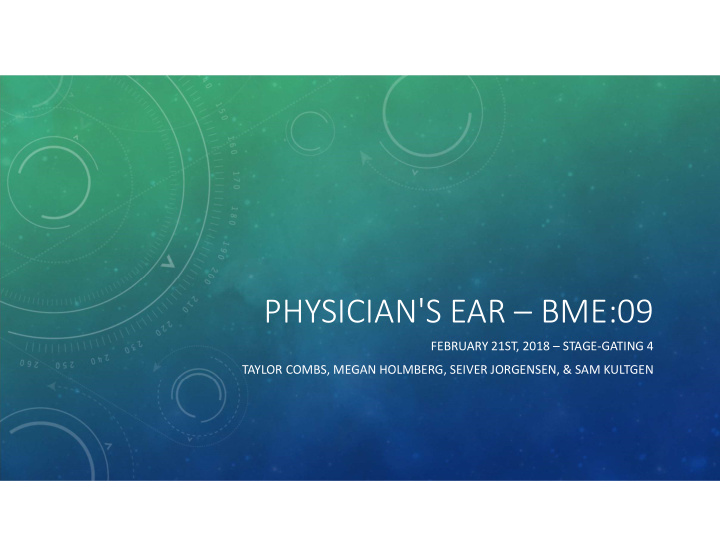



PHYSICIAN'S EAR – BME:09 FEBRUARY 21ST, 2018 – STAGE-GATING 4 TAYLOR COMBS, MEGAN HOLMBERG, SEIVER JORGENSEN, & SAM KULTGEN
Problem Statement Free-field audibly medical alarms are loud and uninformative. The alarms cause sleep deprivation for patients and alarm fatigue for clinicians.
Patient Needs Assessment o Must not infringe on patient confidence in provider o Safety for Patient o Must have informative alarms to improve positive predictive value o Must not interfere with conversation and normal sounds o Must include alert for low battery and system malfunction
Provider Needs Assessment o Provider Efficacy o Interface o Should be available in multiple sizes o Should have volume control o Must be comfortable to wear all day o Should have haptic feedback control o Must stay in ear easily o Should have button to acknowledge receipt of o Transmitted alarms must not overbearing alarm o Should have a haptic component to alarm signal o Safety for Wearer o Must be sterilizable o Must be insulated to prevent shock and excessive o Must have long battery life heating o Should not receive unnecessary alarms to prevent o Must be sweatproof, waterproof alarm fatigue o Must be wireless with stable connection to central hub
System Needs Assessment o Cost Efficacy o Must be able to be purchased in bulk by hospitals or clinics o Should have long shelf life and capability to be activated as needed o Less than $500 per unit o Central Control o Must be able to selectively add patients to individual device o Must be able to direct signal to alert physician and/or nurse by need o Must improve positive predictability of medical alarms.
PROTOCOL
SSRT AND GRAPHIC USER INTERFACE
AfterShokz TREKZ Lofelt Basslet Haptuator Titanium Bone Conductor Headphones
PATENT SEARCH REGULATORY PATHWAY • Related regulatory pathways • No history of similar devices • Blood Pressure Alarm: Class 2 • Class 381 Audio Signal Processing System and Device • Medical Device Information Transfer: Class 1 • Crossover with other medical devices • The sounds we are working with would be Class 2 • Acquires information from them • The device we are proposing would be Class 1 • Wireless connection methods • LG Electronics Inc. Patent application number 20170295455 • Mesh network of Bluetooth devices over a wireless signal • Alarm sounds • Novel or licensed
REIMBURSEMENT & MANUFACTURING COSTS • Not reimbursable • Paid for by Hospital or Medical Center • Suggested maximum unit cost of $500 • Current Estimation: $300 • Similar headsets sell for ~ $125 • Haptuator ankle band sells for ~$150 POTENTIAL MARKET • Hospital Systems • 5,512 acute care hospitals (2015) • 5.3% growth in health care expenditures (2005-2015) • 3.2% GDP growth (2005-2015)
• Finalize communication method between headphones, haptuator, and computer • Build additional soundscapes NEXT STEPS • Establish sound communication through Matlab • Build GUI in Matlab for communication with participant
BIBLIOGRAPHY lirezaee, Parisa, et al. “Did You Feel That? Developing Novel Multimodal Alarms for High Consequence Clinical Environments.” Proceedings of the 23rd International Conference on Auditory Display ICAD 2017 , 2017, doi:10.21785/icad2017.066. Edworthy, J. “Alarms and Human Behaviour: Implications for Medical Alarms.” British Journal of Anaesthesia , vol. 97, no. 1, 2006, pp. 12–17., doi:10.1093/bja/ael114. Edworthy, J. “Fewer but Better Auditory Alarms Will Improve Patient Safety.” Quality and Safety in Health Care , vol. 14, no. 3, Jan. 2005, pp. 212–215., doi:10.1136/qshc.2004.013052. Edworthy, J. “Medical Audible Alarms: a Review.” Journal of the American Medical Informatics Association , vol. 20, no. 3, Jan. 2013, pp. 584–589., doi:10.1136/amiajnl-2012-001061. Edworthy, Judy Reed, et al. “Classifying Alarms: Seeking Durability, Credibility, Consistency, and Simplicity.” Biomedical Instrumentation & Technology , vol. 51, no. s2, 2017, pp. 50–57., doi:10.2345/0899-8205-51.s2.50. Edworthy, Judy, et al. “Improving Auditory Warning Design: Relationship between Warning Sound Parameters and Perceived Urgency.” Human Factors: The Journal of the Human Factors and Ergonomics Society , vol. 33, no. 2, 1991, pp. 205–231., doi:10.1177/001872089103300206 Hasanain, Bassam, et al. “A Formal Approach to Discovering Simultaneous Additive Masking between Auditory Medical Alarms.” Applied Ergonomics , vol. 58, 2017, pp. 500–514., doi:10.1016/j.apergo.2016.07.008. Knox, Richard. “Silencing Many Hospital Alarms Leads To Better Health Care.” NPR, National Public Radio, 27 Jan. 2014, www.npr.org/sections/health-shots/2014/01/24/265702152/silencing- many-hospital-alarms-leads-to-better-health-care. Ruskin, Keith J., and Dirk Hueske-Kraus. "Alarm fatigue: impacts on patient safety." Current Opinion in Anesthesiology 28.6 (2015): 685-690. Schlesinger, Joseph J., et al. “Frequency-Selective Silencing Device for Digital Filtering of Audible Medical Alarm Sounds to Enhance ICU Patient Recovery.” Proceedings of the 23rd International Conference on Auditory Display - ICAD 2017 , 2017, doi:10.21785/icad2017.062. White, Jess. “New for 2016: Joint Commission Updates Alarm Guidelines.” Healthcare News & Insights, Joint Commission, 30 Dec. 2015, www.healthcarebusinesstech.com/alarms-2016/.
Recommend
More recommend